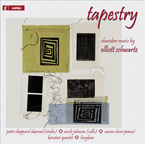 Tapestry: Chamber Music by Elliott Schwartz, Métier msv28537
Tapestry: Chamber Music by Elliott Schwartz, Métier msv28537
Tapestry: Chamber Music By Elliott Schwartz contains a quarter century-long survey of the American composer’s musical perspectives, but the variety of musical and historical influences on this collection of four works reaches into a much deeper past, as Schwartz’s personal connections with the Western canon serve to generate his narratives. Quotation, suggestion, and stylistic interplay assume significant roles in these works, and their placement and manipulation take the listener down fascinating and unexpected paths.
String Quartet No. 2 (2008), the most recent work on the CD, is an homage to Aaron Copland and artist Louise Nevelson. The single movement weaves together an abandoned tone row from Copland’s catalog, a lullaby used by him in several works, as well as spoken quotations pulled from the writings of Copland and Nevelson. This composition bears little resemblance to Copland’s signature harmonic or textural languages, with the exception of a relatively brief, lush progression at the movement’s midpoint. Instead, the work gravitates back and forth between (or occasionally overlaps) darkly lyrical passages and agitated fragments, reflecting the disjunct nature of Nevelson’s sculptural work. The spoken Copland and Nevelson quotations, appearing near the end of the work, reflect Schwartz’s musical tone and structure through clear individual statements initially, followed by overlapped, disjointed statements that quickly fade to whispers, rendering them unintelligible. This addition contributes to the work’s overall sense of distant, hazy images that are just beyond our grasp.
Memorial in Two Parts (1984) for violin and piano, offers brief glances at historical works favored by the composition’s two dedicatees. Monteverdi, Mozart, Schubert, Schumann and Gershwin intermingle in a stylistic menagerie that provides a sense of treasured, but fading, memory. Schumann’s Piano Quintet is the most identifiable quotation here, providing momentary points of cadential repose. But these moments are fleeting as Schwartz’s textures continually evaporate and reconstitute in new forms.
That the recording’s title work, Tapestry (1996), for piano trio, is a Holocaust remembrance may not be apparent to the average listener. Its musical touchstones are generally not obvious ones (quotations from composer and Holocaust victim Gideon Klein, Vaughan Williams’s Fifth Symphony, a Danish folk tune, and a musical realization of Victor Borge’s name), but as with the other works on the CD, memory surfaces in fragmentary fits and starts, creating dramatic dialogues and juxtapositions.
In the closing work, Water Music (2002), Schwartz scores a string orchestra against recorded sounds of running water. The water sounds provide a context for hearing water-related quotes from Smetana, Saint-Saëns, Handel, Wagner, Chopin and Vaughan Williams, but serve little other purpose in the work’s narrative. The piece would work just fine without them.
Elliott Schwartz is a composer in possession of great craft and a deep love of the Western canon. His music swims within the world of memory, however wistful or fragmentary. However, his choices of quotes and styles are personal, and their interconnectedness lives in his memory, not ours. While his employment of quotation and stylistic references adds a rich layer of potential meaning to his works, one does not need to share Schwartz’s connections in order to experience and enjoy his dramatic gestures and stylistic interplay on their own terms. Tapestry presents works of great emotional weight and subtle textural exploration worth discovering in relation to one’s own previous musical memory.


